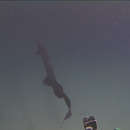The Hexanchiformes /hɛkˈsæŋkɪfɔːrmiːz/ are the order consisting of the most primitive types of sharks,[a] and numbering just seven extant species. Fossil sharks that were apparently very similar to modern sevengill species are known from Jurassic specimens.[2]
Description
Hexanchiform sharks have one spineless dorsal fin located over or behind the pelvic fins and one anal fin. The vertebral column extends into the long dorsal lobe of the caudal fin, while the ventral lobe is either small or absent. They have either six or seven gill slits, located in front of the pectoral fins. They have a large mouth, with eyes on either side of the head. The spiracles are small and located well above and behind the eyes.[3] The eyes have no nictitating membrane. Shark teeth similar to modern hexanchids are known from Devonian deposits in Antarctica and Australia, as well as Permian deposits in Japan. If these are in fact hexanchids, this may be the only extant order of elasmobranchs to have survived the Permian extinction (and by extension, the oldest extant order of elasmobranchs).
The frilled sharks of the genus Chlamydoselachus are very different from the cow sharks, and have been proposed to be moved to a distinct order, Chlamydoselachiformes.
Distribution
Species are widespread and found across most of the world. They are most common in cold deep water in the tropics, but are also found closer to the shore in more temperate regions.[3]
Classification
Living species
Extinct species

Notidanodon sp. fossil at the Geological Museum, Copenhagen
-
Family Chlamydoselachidae
-
Chlamydoselachus Garman, 1884
-
Chlamydoselachus bracheri Pfeil, 1983
-
Chlamydoselachus fiedleri Pfeil, 1983
-
Chlamydoselachus garmani Welton, 1983
-
Chlamydoselachus goliath Antunes & Cappetta, 2002
-
Chlamydoselachus gracilis Antunes & Cappetta, 2002
-
Chlamydoselachus keyesi Mannering & Hiller, 2008
-
Chlamydoselachus landinii Carrillo-Briceño, Aguilera & Rodriguez, 2014
-
Chlamydoselachus lawleyi Davis, 1887
-
Chlamydoselachus tatere Consoli, 2008
-
Chlamydoselachus thomsoni Richter & Ward, 1990
-
Chlamydoselachus tobleri Leriche, 1929
-
Family Crassodontidanidae
-
Crassodontidanus Kriwet & Klug, 2011
-
Crassodontidanus serratus Fraas, 1855
-
Crassodontidanus wiedenrothi Thies, 1983
-
Notidanoides Maisey, 1986
-
Notidanoides muensteri Agassiz, 1843
-
Notidanus Cuvier, 1816
-
Notidanus amalthei Oppel, 1854
-
Notidanus atrox Ameghino, 1899
-
Notidanus intermedius Wagner, 1862
-
Notidanus nikitini Chabakov & Zonov, 1935
-
Pachyhexanchus Cappetta, 1990
-
Pachyhexanchus pockrandti Ward & Thies, 1987
-
Family Hexanchidae
-
Gladioserratus Underwood, Goswami, Prasad, Verma & Flynn, 2011
-
Gladioserratus aptiensis Pictet, 1864
-
Gladioserratus dentatus Guinot, Cappetta & Adnet, 2014
-
Gladioserratus magnus Underwood, Goswami, Prasad, Verma & Flynn, 2011
-
Heptranchias Rafinesque, 1810
-
Heptranchias ezoensis Applegate & Uyeno, 1968
-
Heptranchias howellii Reed, 1946
-
Heptranchias karagalensis Kozlov in Zhelezko & Kozlov, 1999
-
Heptranchias tenuidens Leriche, 1938
-
Hexanchus Rafinesque, 1810
-
Hexanchus agassizi Cappetta, 1976
-
Hexanchus andersoni Jordan, 1907
-
Hexanchus casieri Kozlov, 1999
-
Hexanchus collinsonae Ward, 1979
-
Hexanchus gracilis Davis, 1887
-
Hexanchus hookeri Ward, 1979
-
Hexanchus microdon Agassiz, 1843
-
Hexanchus tusbairicus Kozlov in Zhelezko & Kozlov, 1999
-
Notidanodon Cappetta, 1975
-
Notidanodon brotzeni Siverson, 1995
-
Notidanodon dentatus Woodward, 1886
-
Notidanodon lanceolatus Woodward, 1886
-
Notidanodon loozi Vincent, 1876
-
Notidanodon pectinatus Agassiz, 1843
-
Notorynchus Ayres, 1855
-
Notorynchus borealus Jordan & Hannibal, 1923
-
Notorynchus kempi Ward, 1979
-
Notorynchus lawleyi Cigala Fulgosi, 1983
-
Notorynchus primigenius Agassiz, 1843
-
Notorynchus serratissimus Agassiz, 1843
-
Notorynchus subrecurvus Oppenheimer, 1907
-
Pachyhexanchus Cappetta, 1990
-
Pachyhexanchus pockrandti Ward & Thies, 1987
-
Paraheptranchias Pfeil, 1981
-
Paraheptranchias repens Probst, 1879
-
Pseudonotidanus Underwood & Ward, 2004
-
Pseudonotidanus semirugosus Underwood & Ward, 2004
-
Welcommia Cappetta, 1990
-
Weltonia Ward, 1979
-
Weltonia ancistrodon Arambourg, 1952
-
Weltonia burnhamensis Ward, 1979
-
Family Mcmurdodontidae ?
-
Mcmurdodus White, 1968
-
Mcmurdodus featherensis White, 1968
-
Mcmurdodus whitei Turner, & Young, 1987
-
Family Orthacodontidae
-
Occitanodus Guinot, Cappetta & Adnet, 2014
-
Occitanodus sudrei Guinot, Cappetta & Adnet, 2014
-
Orthacodus Woodward, 1889
-
Sphenodus Agassiz, 1843
-
Sphenodus alpinus Gümbel, 1861
-
Sphenodus longidens Agassiz, 1843
-
Sphenodus lundgreni Davis, 1890
-
Sphenodus macer Quenstedt, 1852
-
Sphenodus nitidus Wagner, 1862
-
Sphenodus planus Agassiz, 1843
-
Sphenodus rectidens Emmons, 1858
-
Sphenodus robustidens Seguenza, 1900
-
Sphenodus tithonius Gemmellaro, 1871
-
Sphenodus virgai Gemmellaro, 1871
Species
See also
Footnotes
References
-
^ Froese, Rainer, and Daniel Pauly, eds. (2009). "Hexanchiformes" in FishBase. January 2009 version.
-
^ Allen, Thomas B. (1999). The Shark Almanac. New York: The Lyons Press. p. 45. ISBN 1-55821-582-4.
-
^ a b Compagno, Leonard J. V.; Dando, Marc; Fowler, Sarah L.; Compagno, Leonard; Fowler, Sarah (2005). A field guide to the Sharks of the world. Collins field guide. London: Collins. ISBN 978-0-00-713610-0.
-
^ "New shark species confirmed: Genetic testing finds a different sixgill shark". ScienceDaily. Retrieved 2020-08-21.
-
^ "New species of shark discovered through genetic testing". phys.org. Retrieved 2020-08-21.
-
^ Matt's, J. & Last P.R. (1998). Paxton, J.R. & Eschmeyer, W.N. (eds.). Encyclopedia of Fishes. San Diego: Academic Press. p. 61. ISBN 0-12-547665-5.


